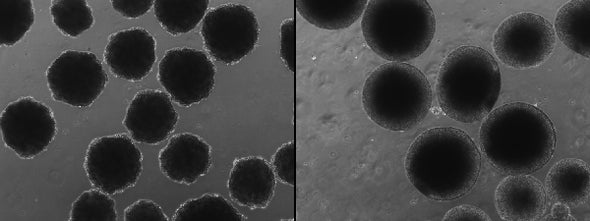We take it for granted that Homo sapiens is the only human species in existence, but it didn’t use to be this way. From the origin of our species a few hundred thousand years ago until a few tens of thousands of years ago, multiple human species shared the planet with our own. What distinguished H. sapiens from other members of the human family, and why did our lineage alone survive to the present day? Scientists have long sought answers to these questions in the fossil and archaeological records. More recently they have started mining the genomes of living and extinct humans—including the Neandertals—for clues.
The Neandertals and the lesser-known Denisovans are our closest evolutionary relatives, so we share a lot of DNA in common with them. But we also have alleles, or genetic variants, that are unique to H. sapiens. Research published online today in Science has identified these sapiens-specific variants and homed in on one in particular that may have brought about a pivotal change in the way our brain develops.
Cleber Trujillo and Alysson Muotri of the University of California, San Diego, and their colleagues compared the genomes of modern humans, Neandertals and Denisovans and found just 61 genetic alterations that distinguish modern humans from our extinct cousins—a strikingly small number. “I was expecting to find hundreds or thousands,” Muotri says.
Muotri reasoned that this handful of altered genes must do important things. But what? As a molecular biologist who studies brain development, he was particularly interested in pinpointing sapiens-specific changes that could significantly affect the brain. He zeroed in on a gene called NOVA1 that is known to control the actions of hundreds of other genes and that figures importantly in the early stages of development. NOVA1 looked like a good candidate to evaluate in Muotri’s experimental system of choice: brain organoids, clusters of cultured brain cells that form miniature versions of specific brain regions, in this case the cortex.
Our version of NOVA1 differs from the version that Neandertals and Denisovans had by a single base pair. To figure out how that alteration affected the functioning of the gene, Muotri and his collaborators needed to know what the archaic version of the gene did. Using CRISPR technology, they replaced the modern human NOVA1 gene in stem cells with archaic NOVA1 and watched as those modified stem cells formed cortical organoids.
The results were striking. Whereas cortical organoids with modern human NOVA1 are spherical, those with archaic NOVA1 developed a popcorn shape. Not only did the archaic organoids look different, their neurons behaved differently. Neurons in organoids with archaic NOVA1 started firing earlier than their fully modern counterparts, indicating that they matured faster than the neurons in organoids with modern NOVA1. And the neural networks in the organoids carrying archaic NOVA1 didn’t develop or function in the same way as those in the wholly modern organoids.
Muotri notes that chimpanzee neurons also mature far more quickly than modern human neurons, which makes sense considering that chimps are much more independent than humans at birth. “A chimp baby will outsmart a human baby,” he says. Our brains take longer to develop, but the payoff is greater cognitive sophistication in adulthood. Perhaps, Muotri speculates, the modern human variant of NOVA1 slowed neuron maturation, giving H. sapiens time to develop more sophisticated brains compared to archaic humans.
J. Gray Camp, a molecular biologist at the University of Basel who was not involved in the new work, praised the team’s study. It “shows that one can resurrect an archaic human allele that has otherwise been lost to history, and study it in a dish,” he says. “That is pretty extraordinary.”
Still, Muotri and his colleagues acknowledge that their approach has limitations. They added a single archaic gene to otherwise modern cells. It is hard to know whether the effects they observed reflect the true function of the archaic gene or whether the mash-up of archaic and modern elements in the organoids produced entirely new traits not found in modern or archaic humans.
Studying the other 60 genes for which modern humans have unique variants might help resolve these uncertainties, Muotri says, especially if researchers could create entire Neandertal cells. Such large-scale genome manipulation is not possible yet, he says, but it might be in two or three years.
In the meantime, further insights into what makes us human may come from other experiments with organoids, which can be made to mimic not only brains but also intestines, skin and other tissues. People today carry some Neandertal DNA as a result of long-ago interbreeding between Neandertals and H. sapiens. Camp and his collaborators have shown that these surviving archaic alleles can be studied in organoids. They are particularly interested in how these archaic gene variants function in the intestine. “Intestinal cells have been exposed to diverse microbes, viruses, nutrients, toxins and other dynamic environmental variables over our evolutionary history,” he says. “We are curious how these pressures have impacted the human intestine.”
Twenty years after the publication of the first drafts of the modern human genome and 11 years after the first draft of the Neandertal genome, it is astounding to think that researchers may finally be closing in on the changes to the code of life that made us us.


